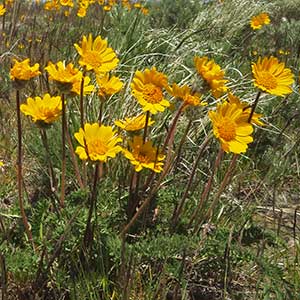Balsamorhiza hookeri
Balsamorhiza careyana
hairy balsamroot, hare's head balsamroot, Hooker's balsam root
Carey's balsamroot
blades usually gray-green, narrowly to broadly lanceolate or ovate, (8–)20–30(–40) × 2–15 cm (1–2-pinnatifid, primary lobes oblong or lanceolate to linear, 5–100 × 0.5–15 mm, secondary lobes usually ± linear, spreading), bases ± truncate to broadly cuneate, ultimate margins usually entire (plane or revolute, ciliate or not), apices obtuse to acute, faces hirsute, sericeous, or strigose (and gland-dotted or finely stipitate-glandular).
blades green, rounded-deltate or deltate to triangular-deltate, 15–25 × 6–15 cm, bases cordate or hastate to truncate, margins usually entire, sometimes crenate (to dentate near bases), apices acute to attenuate, faces finely hispidulous to hirtellous (gland-dotted as well).
campanulate to hemispheric, 15–30 mm diam.
hemispheric to turbinate or campanulate, 12–20 mm diam.
15–30(–45) mm.
20–30(–40) mm (cypselae strigose or glabrous).
ovate-lanceolate to lanceolate, 10–24+ mm, seldom surpassing inner, apices acuminate to attenuate (margins usually ciliate).
oblong to lanceolate or linear, 15–25 mm, usually surpassing inner, apices acute to attenuate.
borne singly.
usually (2–)3+, sometimes borne singly.
= 38.
= 38.
Balsamorhiza hookeri
Balsamorhiza careyana
At one time or another, most species of subg. Balsamorhiza have been synonymized under B. hookeri. Nevertheless, a number of taxa are justifiably segregated as species by their morphologic differences and geographic restrictions. One might logically choose either of two taxonomies: recognizing only two species in the entire genus, one representing subg. Artorhiza and the other subg. Balsamorhiza, or recognizing each slightly differing population as a species. Either course results in an unsatisfactory classification. The present classification is a compromise. A knotty problem persists. A central cluster of populations from eastern Washington to southeastern California display a number of minor and locally discrete morphologies. They tend to be less isolated from each other than are the peripheral populations, although some tend to mimic the latter ones in one or more characteristics. Their evolutionary history may be involved with past hybridizations with each other or with species of subg. Artorhiza, gene drift, and polyploidy. At present, it appears impossible to reach a satisfactory classification.
(Discussion copyrighted by Flora of North America; reprinted with permission.)
Hybrids involving Balsamorhiza careyana and B. deltoidea occur near the Columbia River Gorge; intermediates are found to the east and south. In northern Oregon, plants in some populations have glabrous cypselae and some populations are mixed. The hairiness may come from B. rosea; B. rosea and B. careyana may hybridize profusely, producing mostly plants with the stature of B. careyana and with the relatively short, brick-red ray corollas of B. rosea. Hybridization also occurs, occasionally, between B. careyana and B. sagittata; B. careyana also hybridizes with any species of sect. Balsamorhiza with which it comes in contact. Plants called Balsamorhiza careyana var. intermedia usually have crenate leaf margins and glabrous cypselae.
(Discussion copyrighted by Flora of North America; reprinted with permission.)


